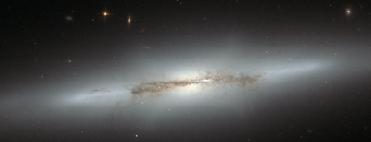
Still an astrophysical mystery, the evolution of bulges in spiral galaxies led astronomers to the edge-on galaxy NGC 4710. When staring directly at the centre of it, one can detect a faint, ethereal
PARIS (BNS): What makes spiral galaxies bear bulges at their centre? Either they formed rather rapidly in the early Universe, before the spiral disc and arms formed; or they built up from material accumulating from the disc during a slow and long evolution.
Astronomers have always been puzzled by this central bulge of spiral galaxies. To find out the answer, they have studied in detail the spiral galaxy NGC 4710.
A member of the giant Virgo Cluster of galaxies located in the constellation of Coma Berenices, NGC 4710 lies about 60 million light-years from the Earth and is an example of a lenticular or S0-type galaxy – a type with characteristics of both spiral and elliptical galaxies.
It is not one of the brightest members of the cluster, but can be easily seen as a dim elongated smudge on a dark night with a medium-sized amateur telescope.
When targeting spiral galaxy bulges, astronomers often seek edge-on galaxies, as their bulges are more easily distinguishable from the disc.
An exceptionally detailed edge-on view of NGC 4710 taken by the Advanced Camera for Surveys on board the NASA/ESA Hubble Space Telescope shows the galaxy's bulge in the brightly coloured centre. The luminous, elongated white plane that runs through the bulge is the galaxy disc. The disc and bulge are surrounded by eerie-looking dust lanes.
If stared constantly at the centre of the galaxy, one could notice a faint, ethereal “X”-shaped structure. Such a feature, which astronomers call a “boxy” or “peanut-shaped” bulge, is due to the vertical motions of the stars in the galaxy's bar and is only evident when the galaxy is seen edge-on.
This curiously shaped ‘puff’ is often observed in spiral galaxies with small bulges and open arms, but is less common in spirals with arms tightly wrapped around a more prominent bulge, such as the NGC 4710, the ESA said.
Astronomers are scrutinising these systems to determine how many globular clusters they host. Globular clusters are thought to represent an indication of the processes that can build bulges.
 Previous Article
Previous Article Next Article
Next Article











The Indian Air Force, in its flight trials evaluation report submitted before the Defence Ministry l..
view articleAn insight into the Medium Multi-Role Combat Aircraft competition...
view articleSky enthusiasts can now spot the International Space Station (ISS) commanded by Indian-American astr..
view article